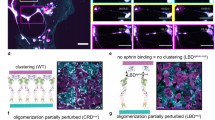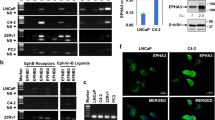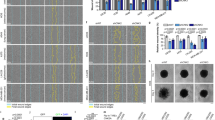Abstract
Metastatic cancer cells typically fail to halt migration on contact with non-cancer cells. This invasiveness is in contrast to normal mesenchymal cells that retract on contact with another cell. Why cancer cells are defective in contact inhibition of locomotion is not understood. Here, we analyse the dynamics of prostate cancer cell lines co-cultured with fibroblasts, and demonstrate that a combinatorial code of Eph receptor activation dictates whether cell migration will be contact inhibited. The unimpeded migration of metastatic PC-3 cells towards fibroblasts is dependent on activation of EphB3 and EphB4 by ephrin-B2, which we show activates Cdc42 and cell migration. Knockdown of EphB3 and EphB4 restores contact inhibition of locomotion to PC-3 cells. Conversely, homotypic collisions between two cancer cells results in contact inhibition of locomotion, mediated by EphA–Rho–Rho kinase (ROCK) signalling. Thus, the migration of cancer cells can switch from restrained to invasive, depending on the Eph-receptor profile of the cancer cell and the reciprocal ephrin ligands expressed by neighbouring cells.
This is a preview of subscription content, access via your institution
Access options
Subscribe to this journal
Receive 12 print issues and online access
$209.00 per year
only $17.42 per issue
Buy this article
- Purchase on Springer Link
- Instant access to full article PDF
Prices may be subject to local taxes which are calculated during checkout








Similar content being viewed by others
Change history
19 November 2010
In the version of this article initially published online, Fig. 4c was incorrectly labelled on the y axis. This error has been corrected in both the HTML and PDF versions of the article.
References
Abercrombie, M. Contact inhibition in tissue culture. In Vitro 6, 128–142 (1970).
Abercrombie, M. & Turner, A. A. Contact reactions influencing cell locomotion of a mouse sarcoma in culture. Med. Biol. 56, 299–303 (1978).
Paddock, S. W. & Dunn, G. A. Analysing collisions between fibroblasts and fibrosarcoma cells: fibrosarcoma cells show an active invasionary response. J. Cell Sci. 81, 163–187 (1986).
Abercrombie, M. Contact inhibition and malignancy. Nature 281, 259–262 (1979).
Vesely, P. & Weiss, R. A. Cell locomotion and contact inhibition of normal and neoplastic rat cells. Int. J. Cancer 11, 64–76 (1973).
Gaggioli, C. et al. Fibroblast-led collective invasion of carcinoma cells with differing roles for RhoGTPases in leading and following cells. Nat. Cell Biol. 9, 1392–1400 (2007).
Wyckoff, J. et al. A paracrine loop between tumor cells and macrophages is required for tumor cell migration in mammary tumors. Cancer Res. 64, 7022–7029 (2004).
Carmona-Fontaine, C. et al. Contact inhibition of locomotion in vivo controls neural crest directional migration. Nature 456, 957–961 (2008).
Stramer, B. et al. Clasp-mediated microtubule bundling regulates persistent motility and contact repulsion in Drosophila macrophages in vivo. J. Cell Biol. 189, 681–689 (2010).
Kullander, K. & Klein, R. Mechanisms and functions of Eph and ephrin signalling. Nat. Rev. Mol. Cell Biol. 3, 475–486 (2002).
Poliakov, A., Cotrina, M. & Wilkinson, D. G. Diverse roles of eph receptors and ephrins in the regulation of cell migration and tissue assembly. Dev. Cell 7, 465–480 (2004).
Pasquale, E. B. Eph–ephrin bidirectional signaling in physiology and disease. Cell 133, 38–52 (2008).
Pasquale, E. B. Eph receptor signalling casts a wide net on cell behaviour. Nat. Rev. Mol. Cell Biol. 6, 462–475 (2005).
Noren, N. K. & Pasquale, E. B. Eph receptor-ephrin bidirectional signals that target Ras and Rho proteins. Cell Signal 16, 655–666 (2004).
Merlos-Suarez, A. & Batlle, E. Eph–ephrin signalling in adult tissues and cancer. Curr. Opin. Cell Biol. 20, 194–200 (2008).
Surawska, H., Ma, P. C. & Salgia, R. The role of ephrins and Eph receptors in cancer. Cytokine Growth Factor Rev. 15, 419–433 (2004).
Mickey, D. D., Stone, K. R., Wunderli, H., Mickey, G. H. & Paulson, D. F. Characterization of a human prostate adenocarcinoma cell line (DU 145) as a monolayer culture and as a solid tumor in athymic mice. Prog. Clin. Biol. Res. 37, 67–84 (1980).
Kaighn, M. E., Narayan, K. S., Ohnuki, Y., Lechner, J. F. & Jones, L. W. Establishment and characterization of a human prostatic carcinoma cell line (PC-3). Invest. Urol. 17, 16–23 (1979).
Kozlowski, J. M. et al. Metastatic behavior of human tumor cell lines grown in the nude mouse. Cancer Res. 44, 3522–3529 (1984).
Zhu, A., Zhang, C. X. & Lieberman, H. B. Rad9 has a functional role in human prostate carcinogenesis. Cancer Res. 68, 1267–1274 (2008).
Huang, X., Wu, D., Jin, H., Stupack, D. & Wang, J. Y. Induction of cell retraction by the combined actions of Abl–CrkII and Rho–ROCK1 signaling. J. Cell Biol. 183, 711–723 (2008).
Parri, M. et al. EphrinA1 activates a Src/focal adhesion kinase-mediated motility response leading to rho-dependent actino/myosin contractility. J. Biol. Chem. 282, 19619–19628 (2007).
Chaib, H., Cockrell, E. K., Rubin, M. A. & Macoska, J. A. Profiling and verification of gene expression patterns in normal and malignant human prostate tissues by cDNA microarray analysis. Neoplasia 3, 43–52 (2001).
Huusko, P. et al. Nonsense-mediated decay microarray analysis identifies mutations of EPHB2 in human prostate cancer. Nat. Genet. 36, 979–983 (2004).
Xia, G. et al. EphB4 expression and biological significance in prostate cancer. Cancer Res. 65, 4623–4632 (2005).
Lee, Y. C. et al. Investigation of the expression of the EphB4 receptor tyrosine kinase in prostate carcinoma. BMC Cancer 5, 119 (2005).
Wegmeyer, H. et al. EphA4-dependent axon guidance is mediated by the RacGAP α2-chimaerin. Neuron 55, 756–767 (2007).
Iwasato, T. et al. Rac–GAP α-chimerin regulates motor-circuit formation as a key mediator of EphrinB3/EphA4 forward signaling. Cell 130, 742–753 (2007).
Nakayama, M. et al. Rho-kinase phosphorylates PAR-3 and disrupts PAR complex formation. Dev. Cell 14, 205–215 (2008).
Bostwick, D. G., Leske, D. A., Qian, J. & Sinha, A. A. Prostatic intraepithelial neoplasia and well differentiated adenocarcinoma maintain an intact basement membrane. Pathol. Res. Pract. 191, 850–855 (1995).
Bracke, M. E. et al. Functional downregulation of the E-cadherin–catenin complex leads to loss of contact inhibition of motility and of mitochondrial activity, but not of growth in confluent epithelial cell cultures. Eur. J. Cell Biol. 74, 342–349 (1997).
Huttenlocher, A. et al. Integrin and cadherin synergy regulates contact inhibition of migration and motile activity. J. Cell Biol. 141, 515–526 (1998).
Takai, Y., Miyoshi, J., Ikeda, W. & Ogita, H. Nectins and nectin-like molecules: roles in contact inhibition of cell movement and proliferation. Nat. Rev. Mol. Cell Biol. 9, 603–615 (2008).
Etienne-Manneville, S. Cdc42—the centre of polarity. J. Cell Sci. 117, 1291–1300 (2004).
Irie, F. & Yamaguchi, Y. EphB receptors regulate dendritic spine development via intersectin, Cdc42 and N-WASP. Nat. Neurosci. 5, 1117–1118 (2002).
Penzes, P. et al. Rapid induction of dendritic spine morphogenesis by trans-synaptic ephrinB–EphB receptor activation of the Rho-GEF kalirin. Neuron 37, 263–274 (2003).
Marston, D. J., Dickinson, S. & Nobes, C. D. Rac-dependent trans-endocytosis of ephrinBs regulates Eph–ephrin contact repulsion. Nat. Cell Biol. 5, 879–888 (2003).
Noren, N. K. & Pasquale, E. B. Paradoxes of the EphB4 receptor in cancer. Cancer Res. 67, 3994–3997 (2007).
Genander, M. et al. Dissociation of EphB2 signaling pathways mediating progenitor cell proliferation and tumor suppression. Cell 139, 679–692 (2009).
Cortina, C. et al. EphB–ephrin-B interactions suppress colorectal cancer progression by compartmentalizing tumor cells. Nat. Genet. 39, 1376–1383 (2007).
Kumar, S. R. et al. Preferential induction of EphB4 over EphB2 and its implication in colorectal cancer progression. Cancer Res. 69, 3736–3745 (2009).
Bochenek, M. L., Dickinson, S., Astin, J. W., Adams, R. H. & Nobes, C. D. Ephrin-B2 regulates endothelial cell morphology and motility independently of Eph-receptor binding. J. Cell. Sci. 123, 1235–1246 (2010).
Stephenson, S. A., Slomka, S., Douglas, E. L., Hewett, P. J. & Hardingham, J. E. Receptor protein tyrosine kinase EphB4 is up-regulated in colon cancer. BMC Mol. Biol. 2, 15 (2001).
Munarini, N. et al. Altered mammary epithelial development, pattern formation and involution in transgenic mice expressing the EphB4 receptor tyrosine kinase. J. Cell Sci. 115, 25–37 (2002).
Hooper, S., Marshall, J. F. & Sahai, E. Tumor cell migration in three dimensions. Methods Enzymol. 406, 625–643 (2006).
Matsuoka, H., Obama, H., Kelly, M. L., Matsui, T. & Nakamoto, M. Biphasic functions of the kinase-defective Ephb6 receptor in cell adhesion and migration. J. Biol. Chem. 280, 29355–29363 (2005).
Acknowledgements
We thank H. Ross for technical assistance and I. Hers for advice on immunoprecipitations, M. Brown for BMECs, A. Ziemiecki and A. -C. Andres for anti-EphB4, D. Wilkinson for anti-EphA4 and E. Pasquale for anti-EphB3. We thank P. Martin, N. Perkins and C. Paraskeva for critically reading the manuscript. We are grateful to J. Dovovan and NCRI/MRC ProMPT collaborative for facilitating clinical aspects of the work. This study has been approved by the Southmead Research Ethics Committee and was funded by a Wellcome Trust PhD studentship to J.B., an MRC studentship to S.K. and a Cancer Research UK project grant to C.D.N.
Author information
Authors and Affiliations
Contributions
J.W.A., S.K. and C.D.N. designed experiments. J.W.A. and J.C. performed the RT–PCR, J.B. performed the Cdc42-knockdown experiments, C.D.N. performed microinjection experiments and immunohistochemistry, and J.W.A. carried out all other experiments. D.G. and R.P. provided prostate tissue and J.O., J.W.A. and C.D.N. prepared and analysed prostate immunohistochemistry. J.W.A. and C.D.N. wrote the manuscript.
Corresponding author
Ethics declarations
Competing interests
The authors declare no competing financial interests.
Supplementary information
Supplementary Information
Supplementary Information (PDF 4367 kb)
Supplementary Movie 1
Supplementary Information (MOV 3650 kb)
Supplementary Movie 2
Supplementary Information (MOV 5833 kb)
Supplementary Movie 3
Supplementary Information (MOV 4450 kb)
Supplementary Movie 4
Supplementary Information (MOV 4284 kb)
Supplementary Movie 5
Supplementary Information (MOV 5069 kb)
Supplementary Movie 6
Supplementary Information (MOV 4737 kb)
Supplementary Movie 7
Supplementary Information (MOV 5434 kb)
Supplementary Movie 8
Supplementary Information (MOV 7963 kb)
Supplementary Movie 9
Supplementary Information (MOV 4549 kb)
Supplementary Movie 10
Supplementary Information (MOV 5582 kb)
Supplementary Movie 11
Supplementary Information (MOV 4704 kb)
Rights and permissions
About this article
Cite this article
Astin, J., Batson, J., Kadir, S. et al. Competition amongst Eph receptors regulates contact inhibition of locomotion and invasiveness in prostate cancer cells. Nat Cell Biol 12, 1194–1204 (2010). https://doi.org/10.1038/ncb2122
Received:
Accepted:
Published:
Issue Date:
DOI: https://doi.org/10.1038/ncb2122
This article is cited by
-
Self-assembly of tessellated tissue sheets by expansion and collision
Nature Communications (2022)
-
Non-junctional role of Cadherin3 in cell migration and contact inhibition of locomotion via domain-dependent, opposing regulation of Rac1
Scientific Reports (2020)
-
Single-cell analysis of EphA clustering phenotypes to probe cancer cell heterogeneity
Communications Biology (2020)
-
Modelling chase-and-run migration in heterogeneous populations
Journal of Mathematical Biology (2020)
-
A framework for advancing our understanding of cancer-associated fibroblasts
Nature Reviews Cancer (2020)



